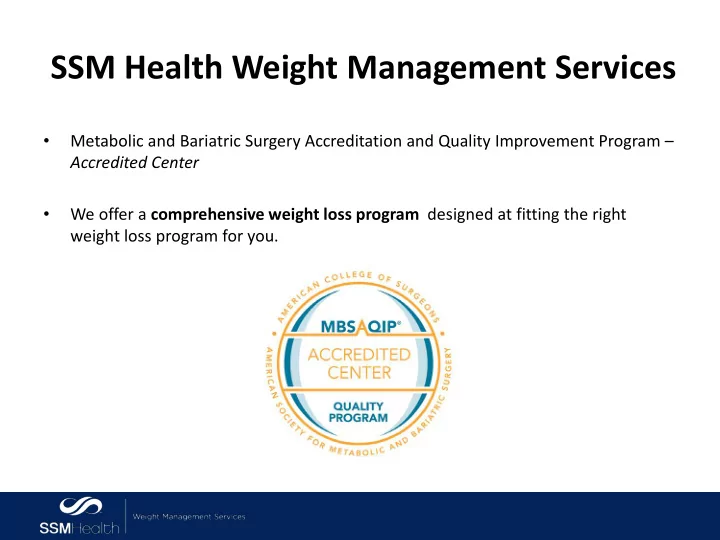

SSM Health Weight Management Services Metabolic and Bariatric Surgery Accreditation and Quality Improvement Program – • Accredited Center • We offer a comprehensive weight loss program designed at fitting the right weight loss program for you.
Medical Director and Bariatric Surgeon Mario Morales, MD • • Graduate of University of California at San Diego School of Medicine • Completed residency at University of Missouri Columbia Advanced fellowship in weight loss • surgery • Mechanical Engineer – assists in the design of instruments Published / Guest Lecturer •
Agenda • Discuss obesity as a disease • Key components to weight loss • Surgical options for weight loss • Sleeve Gastrectomy • Roux-en-Y Gastric Bypass • Duodenal Switch • Gastric Banding
The Cause of Obesity • Not simple • Many factors have been shown to lead to obesity: – Metabolic – Hormonal – Increased caloric consumption – Lack of physical activity – Genetic
Medical Complications of Obesity 1 Pulmonary Disease Idiopathic Intracranial Hypertension Abnormal Function Obstructive Sleep Apnea Stroke Hypoventilation Syndrome Cataracts Nonalcoholic Fatty Coronary Heart Liver Disease Disease Steatosis Diabetes Steatohepatitis Dyslipidemia Cirrhosis Hypertension Severe Pancreatitis Gall Bladder Disease Cancer Gynecologic Abnormalitie s Breast, Uterus, Cervix, Abnormal Menses Colon, Esophagus, Pancreas, Infertility Kidney, Prostate Polycystic Ovarian Syndrome Osteoarthritis Phlebitis Skin Venous Stasis Gout 1. Obesity OnLine slide presentation. Accessed May 17, 2007. Accessible as slide #5 at http://www.obesityonline.org/slides/slide01.cfm?tk=33.
Treatment of Obesity • Weight loss is not easy – Significant long term weight loss is often not successful for many patients • Aggressive intervention is required for long-term success – Diet and exercise are still the foundation – Tools are needed to help control caloric intake
What’s Your BMI? Weight (lbs) 150 160 170 180 190 200 210 220 230 240 250 120 130 140 260 270 280 290 300 5'0" 5'2 " 5'4" Height 5'6" 5'8" 5'10" 6'0" 6'2" 6'4"
Obesity Categories Obese Obese Extremely Obese Overweight Normal Weight (Class I) (Class II) (Class III) (BMI 25 to (BMI* 18.5 to (BMI 30 to (BMI 35 to (BMI 40 or 29.9) 24.9) 34.9) 39.9 ) more) BMI (Body Mass Index): A measurement of an individual’s weight in relation to height (kg/m 2 ). National Institutes of Health/National Heart, Lung and Blood Institute Clinical Guidelines Evidence Report. NIH Publication 98-4083, September 1998.
Surgical Weight Loss Options • Adjustable gastric banding • Sleeve gastrectomy • Roux-en-Y gastric bypass Effectiveness Risks • Biliopancreatic diversion Duodenal Switch • Qualifications – Surgical Options • BMI of 40 or over • BMI of 35-40 with significant co-morbidity • MOST EFFECTIVE OPTION FOR LONG TERM WEIGHT LOSS
Laparoscopic Weight Loss Surgery • Fewer wound complications • Less pain • Shorter hospital stay • Earlier return to work
Weight-Loss Procedures • Restriction – Adjustable gastric banding • Restriction with Hormonal Changes – Sleeve gastrectomy • Restriction and malabsorption – Roux-en-Y gastric bypass (more restrictive) – Duodenal Switch (more malabsorptive)
Vertical Sleeve Gastrectomy • Restrictive with hormonal changes • Newest procedure offered • Has become most commonly performed procedure in U.S. • Early 60-65% excess weight loss or 60-65 lbs in person 100 lbs overweight • 1-2 night stay • Off work 1-2 weeks • Follow-up at 1 wk, 1 mth, 6 mths then yearly
Sleeve Gastrectomy
Roux-en-Y Gastric Bypass • Combination of restrictive and malabsorptive • First done in 1967 • Laparoscopically since 1993 • 75% excess weight loss or 75 lbs in person 100 lbs overweight • 1-2 night stay • Off work 1-2 weeks • Follow-up at 1 wk, 1 mth, 6 mths then yearly
Roux-en-Y Gastric Bypass
Duodenal Switch • Combination of restrictive and super malabsorptive • 80% excess weight loss or 80 lbs in person 100 lbs overweight • High co-morbid resolution • 2-3 night stay • Follow-up at 1 wk, 1 mth, 3mths, 6 mths, 9 mths, 12 mths then yearly • NOT all insurances cover this procedure!
Duodenal Switch
Possible Risks and Complications Complication Lap-Band Sleeve Gastrectomy Gastric Bypass Duodenal Switch Death Approx 0% 1/1000 1/1000 1/1000 Infection 1-2% 1-2% 1-2% 1-2% Major bleeding <1% <1% 1% 1% Leak NA <1% 1-2% 1-2% GI Issues From complication of Nausea early, rare for Upper GI SEs (chronic Gas and Diarrhea band long term side effects nausea, pain with (lower GI system) eating, dumping) Malnutrition (i.e. losing Rare Very uncommon <1-2% 3% too much weight) Erosion of band <1% NA NA NA Obstruction From band slip From kinking of sleeve 1% per year, internal 1% per year, internal or stricture (<1%) hernia or scar tissue hernia or scar tissue DVT/PE Rare 0.5% 0.5% 0.5% Stricture/ulcer NA <2% Up to 15% usually if <10% smoke or use NSAIDs Others: need for reoperation, cardiopulmonary dysfunction, kidney dysfunction Reference: 1. Chapman A, Game P, O’Brien P. Laparoscopic adjustable gastric banding for the treatment of obesity: update and re-appraisal. ASERNIP-S Report No. 31, Second Edition. Adelaide, South Australia. ASERNIP-S, June 2002.
QUESTIONS?
Laparoscopic Adjustable Gastric Banding • Restrictive • 50% average excess body weight loss • Approx. 50 lb weight loss in person 100 lbs overweight • Outpatient surgery • Follow-up at 1 week then monthly for adjustments
Adjustable Gastric Banding
Intragastric Balloon • BMI 30-40 kg/m 2 • Willingness to participate in comprehensive weight loss program including physicians, dieticians, mental health providers and exercise counselors • Ability to pay for procedure • Weight loss 3x as high as diet and exercise • Average 22lb weight loss in first 6 months
Intragastric Balloon Placement
Intragastric Balloon Removal
Intragastric Balloon Complication • Nausea and Vomiting • Balloon rupture • Balloon deflation • Inadequate weight loss • Early Removal • Injury to esophagus or stomach • Bowel obstruction
Recommend
More recommend